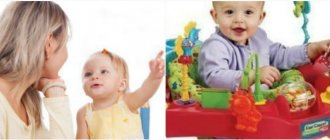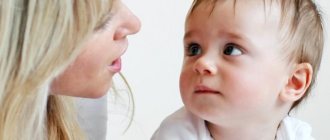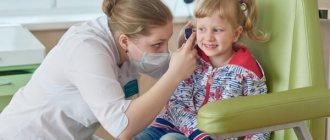Article:
All parents, without exception, wait for the moment when the child begins to say mom and dad.
Many people think that children's speech begins to develop on the day the baby pronounces the first word. In fact, for this to happen, we need long-term preparation of the articulation organs, their coordinated work, the ability to switch, mobility of the lower jaw, lips, tongue, and soft palate. It is impossible to pronounce exactly those sounds that make up the first words if the child does not know how to distinguish them from phonemes that sound similar, for example, words such as cat-whale, slide-crust and others. More precisely, human speech is formed during the prenatal period, when the organs of hearing, articulation and brain structures are formed. These processes are influenced by heredity, illnesses suffered by the mother, the presence or absence of bad habits, and the lifestyle of the baby’s parents. The course of labor and the state of health of the baby are important factors in his successful debut as a speaking and thinking person.
We will tell you at what age children begin to speak their first sounds, what this depends on, at what age children begin to speak in sentences, and how to help them go through each stage of speech development in a timely manner.
Speech in the first weeks and months of life
Immediately after birth, intensive development of brain structures begins, and new connections between neurons are established. At the same time, the organs of hearing and articulation develop, and physical and phonemic hearing is formed. Without proper hearing, children cannot master speech, since distortion or absence of sound signals entering the brain makes it impossible to develop speech skills.
In the first weeks and months of life, it is the speech of others that stimulates the initial stage of speech development. The baby listens to the speech of loved ones, he calms down for a while when he hears his mother’s voice, the impulsive movements of his arms and legs stop for a while. After some more time, he begins to turn his head towards the source of the sound.
Not all mothers and fathers talk to newborns and infants in the first months of life. They think this is unnecessary, because the baby doesn’t understand anything yet. Such one-sided “conversations” between parents and children, which accompany their bathing and waking, develop auditory concentration and the desire to respond. Attentive parents may notice how the child tries to move his lips, as if he wants to say something. It’s even better if parents often call the baby by name, show him toys, call the child, not moving much away from the crib.
This is the age at which a child begins to speak vowels and consonants. Up to 3 months, the child pronounces the following sounds:
- vowels – A, U, E;
- consonants – M, K, X, P, B, G.
These phonemes still sound unclear and are pronounced involuntarily. These skills mark the first stage of speech development – humming. In addition, the cry of a 1–3 month old baby is quite expressive. By intonation, the mother can determine whether the baby is bored, wants to eat, or it’s time to change wet diapers, that is, he has begun to master intonation.
What affects children's speech development
Speech development is one of the most difficult, but also the most important stages in a person’s life.
The formation of the ability to express oneself is influenced by many factors, among which are:
- Auditory attention. Without well-developed hearing, children will not be able to learn speech, because in order to repeat something, they must first hear it. To develop auditory attention, parents should engage with their children. For example, let them listen to music, train them to understand where the sound comes from. In the latter case, rattles will help. In a conversation, you can use different intonations to develop an understanding that the child is being praised or, conversely, that you are dissatisfied with his behavior. In addition, changing intonation allows you to train the formation of speech tempo.
- Motor development. Language and motor development are closely related, as we have already discussed. Therefore, in order to develop the language component, it is advisable to use games that force the child to actively move. True, at such a young age it is difficult for a baby to control his movements, especially with regard to fine motor skills, which physiologically develop later than gross motor skills. And don’t forget about articulatory motor skills. Smiles, various “faces”, clicking of the tongue, etc. activates the muscles responsible for the correct formation of sounds.
- Intellectual growth. The intellectual development of a child directly affects the rate of his language development. There is an opinion among the common people that a stupid child will speak later than a smart one. In fact, the pace of a baby’s intellectual development can be accelerated. There are special techniques for this. Even ordinary games stimulate the baby's intelligence. The main thing is to work with the child systematically and not overload him, trying to “fashion” a child prodigy.
- Emotional development. Emotionality stimulates faster development of speech. This is why we instinctively talk to a child more emotionally than to adults. This helps him more accurately determine intonation and make him want to respond with emotion to emotion.
- Communication. A child will speak faster if he has someone to do it with. Communication with parents is, of course, good, but it will be useful for kids to communicate with other children. Therefore, it is advisable to go out with your child more often to playgrounds, etc.
The main rule is to work with children. The more effort you put into their development, the faster you will get the return. In infancy, children absorb information like sponges.
From humming to babbling
At the beginning of the fourth month, the baby begins to look for an adult, smiles, and begins to intensively move his arms and legs (revitalization complex). He begins to emit drawn-out and melodious combinations of sounds - he cooes, saying a-a, a-gu, a-ha. Some sounds are simply impossible to reproduce; such phonemes do not exist in the Russian language.
After another 2–3 months, the turn of babbling comes. At first these are individual syllables pa, ka, na, ma, which a little later become similar to the peculiar words pa-pa-pa, ka-ka-ka, na-na-na. Most often, babbling appears when the baby is full, has slept and is in a good mood. This is not yet a speech, but preparation for it, a kind of preparatory exercise.
Although he does not speak yet, he understands a lot - he turns his head when he is shown a familiar toy, a bird, a cat. Children 6-7 months old fulfill simple requests - give a pen, play palms, and this is also a step towards speech development.
Average age for children to develop conscious speech
At 9-10 months, babies pronounce words unconsciously.
They only pronounce various syllables and imitate the speech of their parents. But the baby already understands what adults are telling him, and his vocabulary continues to expand. Already by 11-12 months, the baby begins to pronounce simple words consciously. Usually these are “mother”, “father”, “woman”, “grandfather”, the names of favorite toys, animals. In total, there are approximately 10 words in the lexicon. By the age of one and a half years, a child can consciously pronounce about 20 words.
By the age of two, many children can already form simple sentences. To stimulate the development of conscious speech in a child, it is necessary to conduct educational activities in the form of a game. For example, Doman cards develop a child well.
They are bright pictures of different subjects (weather, animals, vegetables). It is necessary to show them to the baby and at the same time name what is depicted on them. It is important to talk to your baby as often as possible. When communicating, you should use simple words.
The baby begins to consciously pronounce words closer to 11-12 months.
How to stimulate babbling
From 6 months, children are able to move in space - sit and crawl. Their perception improves, they can repeat sounds after adults. This skill can be developed - as soon as the child pronounces the syllables, the parents repeat them after him. This technique develops hearing, articulation organs, speech exhalation, and encourages the baby to pronounce these syllables again and again. Such mini-lessons are carried out with a cheerful, well-fed and healthy baby. If he is cold, hungry, or unwell, verbal games with his parents will not do any good.
It’s good if the child sees the face of the one who is talking to him, then he will be able to repeat the movements of his mother or father’s lips. In order for sounds to be heard clearly, you need to ensure complete silence - turn off the music, mute the sound of the TV.
You can play “hide and seek” by covering the baby’s face with a diaper and saying “peek-a-boo.” Showing adults objects of the environment develops passive vocabulary well. In this case, you need to clearly name them, accompanied by a pointing gesture. Soon the child will find them with his eyes, reacting to the adult’s question “Where is the watch?”, “Where is the cat?”, “Where is the car?”
What are the first words?
Now let’s dispel the myth about the first word. Today in pediatrics it is customary to consider the first word to be one that is used in the same meaning and refers to the same objects or actions. That is, with this approach, the baby’s vocabulary may contain distortions and onomatopoeia (kaka, wawa, tsatsa, aw-aw, bibika, am-am). At the same time, “wava” means a lot of objects or actions that cause pain, “kaka” means everything that is dirty or not suitable for food. In such cases, we can assume that the child says the first word (otherwise, such syllable combinations are a sign of babbling). For the appearance of such words, the approximate age will be 10–12 months.
At the beginning of mastering the skill of speaking, the baby pronounces words consisting of one repeated syllable or two different ones. More significant achievements will come later - everything has its time.
The baby says the first word associatively, relating it to the object in the field of vision and to the analogies that it evokes in the baby. A child’s first word is not always “mama.” For example, an adult may not understand that a car tire is called “katan” (the kid saw dad rolling it once and remembered the association: dad said “roll”). Or, while playing in the bathtub with rubber ducklings, I remembered that “ducklings” can be found in water. When he sees a puddle or lake on a walk, he can now say “duck.”
If the association is stable and can be recognized, the child speaks words. Moreover, if a child under 2 years of age has not seen ducks in life or in pictures, he will not say this word.
When do the first words and phrases appear?
It is impossible to name the exact date at which children begin to speak their first words. They can appear at 8–9 months and at 1 year 2 months. And all this is the norm. According to the observations of parents and teachers, girls usually start talking earlier than boys, although there are exceptions. At the turn between the first and second years, the baby’s vocabulary contains from 2 to 20 words. Usually this:
- simplified words (ma-ma, pa-pa, la-la, ki-sa, am-am);
- onomatopoeia (beep, peek-a-boo, peep-peep).
It is at this age that the child speaks to his mother. Why do children pronounce words in their native language? Because the adults around him single out from the baby’s babbling syllables and sound combinations that are inherent specifically in their language system, and repeat only them. Therefore, the period of babbling is important for the development of children's speech.
At one and a half years or a little later, the baby begins to combine words into sentences, as long as they consist of two words. The words in them are not consistent, an example of the following phrase: “Give me a doll” (give me a doll), “Papa is not there” (dad is not at home). But this is the age when attentive mothers notice that their baby begins to speak in sentences.
WE HELP TO SPEAK
It is usually believed that girls begin to speak a little earlier, they are more emotional and spontaneous. Although one can argue with this: each baby develops individually. There are reserved girls and active boys, and it is impossible to predict which of them will start speaking in sentences first. And the point is not only in natural inclinations, but also in what, how and how much parents do with the child in order to stimulate the development of his speech skills.
What does it mean to stimulate? “Push” the speech apparatus, improve the baby’s movements and do everything so that he is ready to speak as early as possible. How to achieve this? Comprehensively influence the child’s brain centers responsible for the development of fine and gross motor skills, thinking, and a sense of balance, which are associated with the center of speech; develop articulatory and conceptual apparatus. The exercises and activities below will help with this.
- From about 4 months, the baby needs to be taught to touch and feel, and then grab a variety of objects (differing in size, materials, texture, properties), developing his tactile sensations. Fine motor skills are stimulated by rubbing massage and finger games. As he gets older, the baby will be able to manipulate small objects: twist, knock, lay out, string, screw, etc.
- It is useful to change the child’s position in space: tilt, lift, circle, turn over, swing. Subsequently, the vestibular apparatus is trained by children's bicycles, swings, ball games, and walking on a log.
- It is imperative to develop a child’s articulatory apparatus. To do this, it is good to play imitation of different sounds (wind, rain, the noise of a vacuum cleaner, the hum of an airplane or car) or play at the zoo, imitating the voices of a variety of animals. At the same time, the mother must clearly and slowly show the baby how she receives sound. It’s even better to do this in front of a mirror, so the baby learns to compare his actions with his mother’s. Such simple articulation gymnastics is quite enough at first. More complex exercises for older children can be found here.
- Reading books, poems, and nursery rhymes helps the child learn the rhythm of speech, intonation, and enrich his passive vocabulary.
- An active speech environment is an indispensable condition for a child to speak in a timely manner: first in simple words, and then in phrases. You need to constantly talk with your baby about everything: what is happening, what is needed for what, what is it called, where are we going, why, etc. Even if the child is not yet able to repeat all this, he accumulates a passive vocabulary, enriches his horizons and constantly has Here is an example that verbal communication is necessary.
- Singing also promotes speech development. When a mother sings, the child develops hearing, memory, and a sense of rhythm. When he sings himself, the muscles of the articulatory apparatus are relaxed, which makes it easier to master sound pronunciation.
- After a year, it is useful to sometimes turn on the “misunderstanding mother.” During this period, children usually actively use facial expressions or gestures (especially the index finger). Therefore, if you indulge your baby all the time, giving or allowing everything that he expresses with gestures, he simply will not have the need to use speech. And if the mother stubbornly does not understand the baby, she will have to work hard to somehow express her desires using words.
For proper speech development, it is important to develop breathing. Poor breathing can cause your child to speak too softly. Or he will calm down towards the end of a short phrase, gasping for air in the middle of a word, speaking excitedly.
Simple games that your baby will play with pleasure help improve breathing:
- you can blow out the candles;
- blow (pipe, whistle, horn - any children's musical instrument will do);
- blow bubbles in a glass of water (by blowing into it through a straw);
- blow bubbles;
- blow on dandelions or on a paper butterfly tied to a string;
- blow paper or cotton pieces off a table or plate;
- blowing on toys in the bathroom while bathing.
To ensure that your little one begins to speak promptly and correctly, always set an example for your child to speak correctly. Constant lisp and distortion of words following the example of a baby, at his speech level, will lead to the fact that he will internalize this as the norm. Let him say “meow”, and you answer: “Yes, it’s a cat.” And explain what he doesn’t yet understand using concepts that he already knows.
How to stimulate the pronunciation of words at 1 year old
By the age of 1, speech is not yet the most important means of communication for children. It is necessary to teach the baby to use speech. To do this, you do not need to immediately give the toy that the baby wants to take. First you need to say the name of the toy (you can simplify it): “Should I give you a la-la?” Let the baby try to repeat “la-la”, “beep-beep”. When presenting the desired item, you can emphasize: “This is lala, na.”
The vocabulary of an adult communicating with a baby should contain both full and abbreviated words: “kar-kar”, “ding-ding”, “knock-knock”, “tick-tock”. These substitutes for full words are temporary and are needed only because they are easier for the child to pronounce.
In order for children to establish a connection between a word and an action, you need to ask him to perform some action: give or take a toy, show a familiar object, wave a hand. Also verbalize all the actions that he performs with toys. For the same purpose, they play with 2–4 familiar toys and ask the baby, for example, to take a ball, throw it or catch it. Adults carry out all actions emotionally, clearly pronouncing both words-objects and words-actions.
What does a baby say from one year to two?
At the age of one to one and a half years, children introduce phrases into speech. The child begins to understand shapes and colors well, recognizes animals and household objects, and can point to fairy-tale characters. Speech is quickly enriched: the child learns to speak in sentences that gradually become longer.
Closer to 2 years, the child will begin to ask and formulate questions. Gradually understands more and more complex requests, better describes what he observes around him.
Tips for active parents
The development of a baby’s speech directly depends on whether it develops spontaneously, or whether parents take direct part in its development. This determines at what age children begin to speak sounds/words/sentences. Positive conditions for the formation of children's speech:
- There is no need to force speech development with frequent exercises that are not appropriate for the baby’s age - there is a high risk of speech negativism, stuttering and nervous tics, since the capabilities of the child’s brain are not limitless.
- There is no need to lisp, faking your speech as a child’s speech, and often use diminutive suffixes - the only thing worse than this can be a complete disregard for communication.
- Delicately correct speech mistakes made by your child, never make him laugh, but show him an example of the correct pronunciation of a given speech utterance. For example, I see houses, yes, you see houses.
- Protect your baby from communicating with people with speech defects (burr, stutter), and especially with illiterate speaking adults (put down - lies, mouths - mouths, beautiful cat - beautiful cat), this “infects” and “invades” children’s speech so much that Such imitations are eradicated with great difficulty.
- When reading children's works, watching cartoons with your child, always explain unfamiliar words, the actions of the characters, and pay attention to vivid turns of speech.
It is very useful to record and listen to the baby’s speech every month - humming, babbling, first phrases, reading poetry. Such an archive will one day become an excellent gift for an older child and your grandchildren.
Today we answered the question of when should a child start speaking and at what months do the first sounds appear. If you suspect a delay in speech development in your baby, consult us. We will dispel anxiety, and if it is objective, we will tell you how to talk or simply teach your child to speak. We know more than a dozen examples of how parents sit and wait for their child to speak at 3, 4 and even 5 years old, although the development of big problems is already clearly visible. Ask us, we've been doing this all our lives!
If the child does not speak
Some children develop language faster, while others may take longer to speak.
A child of talking age (one to two years) who does not speak may know as many words as a child who speaks, but simply does not want to use them. The reason may be natural shyness. It is also believed that girls develop speech faster than boys. If you still think that your baby is lagging behind in speech development, you should not ignore it - share your observations with your pediatrician. Speech development delays respond well to treatment. The sooner you see a doctor, the sooner your child will receive the help he needs. It is worth showing it to specialists such as an otorhinolaryngologist, pediatric dentist and neurologist. If, according to the doctors’ conclusions, the baby is healthy, but his speech does not correspond to his age, then the next step may be a visit to a speech therapist. Your doctor may also recommend seeing a hearing specialist or speech pathologist. Although you want to quickly hear your baby's first words, it is better to be patient. The child will start talking when he is ready. Your role is to talk with your baby, thereby teaching and inspiring him to speak. One day he will say the first word, and then another and another. Before you know it, he will turn into a little why and bombard you with questions. How this article was written The information presented in this article is based on expert advice published by trusted (medical and government) sources such as the American Pediatric Association and the American College of Obstetricians and Gynecologists. A complete list of links to sources used to write this article can be found at the end of the article. The information on this page is not a substitute for professional medical advice. Always consult your doctor for diagnosis and treatment.










